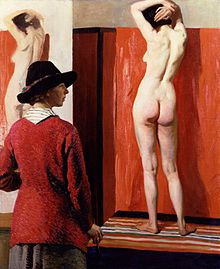Part 1 the Painters
Artemisia Gentileschi (July 8, 1593 – c. 1656) an Italian painter, is today considered one of the most accomplished painters in the generation following that of Caravaggio. In an era when women painters were not easily accepted by the artistic community or patrons, she was the first woman to become a member of the Accademia di Arte del Disegno in Florence. She was known for her powerful naturalistic style, and for her involvement in a rape trial. Her painting of Judith Slaying Holofernes shows a remarkably violent struggle, in contrast to many other paintings of the same scene that show Judith as weak and shrinking.

Elisabeth Louise Le Brun (April 6, 1755 – March 30, 1842) Born in Paris, Vigee le Brun was a successful portrait painter who worked in a Rococo style. She was a great favorite of Marie Antoinette and painted over thirty portraits of the queen and her family. Her paintings were used to “humanize” Marie Antoinette and dispel some of her bad press by showing her as a warm and loving mother. She fled France after the revolution, but continued a successful career as a portraitist to the elite in Italy, Austria, and Russia.

Dame Laura Knight (August 4, 1877 – July 7, 1970) Knight was one of the most popular and successful painters in Britain, and the first woman to be elected to the Royal Academy. She began work as an art teacher at fifteen, to support her ailing mother and sisters. She experienced poverty in much of her early life, and struggled to earn money to live and paint, and this influenced her fascination with marginalized communities and individuals–Gypsies, circus artists, impoverished children. She gained some praise and some criticism for a portrait of herself painting a nude, at a time when women were supposed to see only plaster casts and drawings of naked people. She lived to be 92, and traveled the world, and she was made a Dame Commander of the Order of the British Empire in 1931.

Caterina van Hemessen (1528 – after 1587) The earliest female Flemish painter for whom we have a significant body of work, van Hemessen painted mainly portraits of wealthy patrons. It is believed that her father taught her to paint, which helped her to become a painter despite the fact that “A number of obstacles stood in the way of contemporary women who wished to become painters. Their training would involve both the dissection of cadavers and the study of the nude male form, while the system of apprenticeship meant that the aspiring artist would need to live with an older artist for 4–5 years, often beginning from the age of 9-15.” She is credited with being the first artists, male or female, to paint a self portrait depicting herself seated at an easel.

Tamara de Lempicka (May 16, 1898 – March 18, 1980) Born in Poland to a wealthy and prominent family, Lempicka became the most fashionable portrait painter of her generation, known for her art deco paintings, and for her own fabulous style. “Lempicka’s distinctive and bold artistic style developed quickly, influenced by what André Lhote sometimes referred to as ‘soft cubism‘ and by the ‘synthetic cubism’ of Maurice Denis, epitomizing the cool yet sensual side of the Art Deco movement. For her, Picasso ’embodied the novelty of destruction.’ She thought that many of the Impressionists drew badly and employed ‘dirty’ colors. Lempicka’s technique would be novel, clean, precise, and elegant.”

Sign up for our email list
Find out about new art and collections added monthly